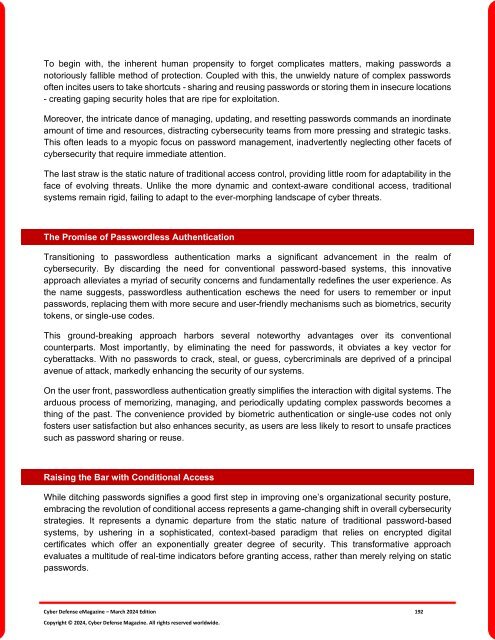The Cyber Defense eMagazine March Edition for 2024
Cyber Defense eMagazine March Edition for 2024 #CDM #CYBERDEFENSEMAG @CyberDefenseMag by @Miliefsky a world-renowned cyber security expert and the Publisher of Cyber Defense Magazine as part of the Cyber Defense Media Group as well as Yan Ross, Editor-in-Chief and many more writers, partners and supporters who make this an awesome publication! 225 page March Edition fully packed with some of our best content. Thank you all and to our readers! OSINT ROCKS! #CDM #CDMG #OSINT #CYBERSECURITY #INFOSEC #BEST #PRACTICES #TIPS #TECHNIQUES
Cyber Defense eMagazine March Edition for 2024 #CDM #CYBERDEFENSEMAG @CyberDefenseMag by @Miliefsky a world-renowned cyber security expert and the Publisher of Cyber Defense Magazine as part of the Cyber Defense Media Group as well as Yan Ross, Editor-in-Chief and many more writers, partners and supporters who make this an awesome publication! 225 page March Edition fully packed with some of our best content. Thank you all and to our readers! OSINT ROCKS! #CDM #CDMG #OSINT #CYBERSECURITY #INFOSEC #BEST #PRACTICES #TIPS #TECHNIQUES
Create successful ePaper yourself
Turn your PDF publications into a flip-book with our unique Google optimized e-Paper software.
To begin with, the inherent human propensity to <strong>for</strong>get complicates matters, making passwords a<br />
notoriously fallible method of protection. Coupled with this, the unwieldy nature of complex passwords<br />
often incites users to take shortcuts - sharing and reusing passwords or storing them in insecure locations<br />
- creating gaping security holes that are ripe <strong>for</strong> exploitation.<br />
Moreover, the intricate dance of managing, updating, and resetting passwords commands an inordinate<br />
amount of time and resources, distracting cybersecurity teams from more pressing and strategic tasks.<br />
This often leads to a myopic focus on password management, inadvertently neglecting other facets of<br />
cybersecurity that require immediate attention.<br />
<strong>The</strong> last straw is the static nature of traditional access control, providing little room <strong>for</strong> adaptability in the<br />
face of evolving threats. Unlike the more dynamic and context-aware conditional access, traditional<br />
systems remain rigid, failing to adapt to the ever-morphing landscape of cyber threats.<br />
<strong>The</strong> Promise of Passwordless Authentication<br />
Transitioning to passwordless authentication marks a significant advancement in the realm of<br />
cybersecurity. By discarding the need <strong>for</strong> conventional password-based systems, this innovative<br />
approach alleviates a myriad of security concerns and fundamentally redefines the user experience. As<br />
the name suggests, passwordless authentication eschews the need <strong>for</strong> users to remember or input<br />
passwords, replacing them with more secure and user-friendly mechanisms such as biometrics, security<br />
tokens, or single-use codes.<br />
This ground-breaking approach harbors several noteworthy advantages over its conventional<br />
counterparts. Most importantly, by eliminating the need <strong>for</strong> passwords, it obviates a key vector <strong>for</strong><br />
cyberattacks. With no passwords to crack, steal, or guess, cybercriminals are deprived of a principal<br />
avenue of attack, markedly enhancing the security of our systems.<br />
On the user front, passwordless authentication greatly simplifies the interaction with digital systems. <strong>The</strong><br />
arduous process of memorizing, managing, and periodically updating complex passwords becomes a<br />
thing of the past. <strong>The</strong> convenience provided by biometric authentication or single-use codes not only<br />
fosters user satisfaction but also enhances security, as users are less likely to resort to unsafe practices<br />
such as password sharing or reuse.<br />
Raising the Bar with Conditional Access<br />
While ditching passwords signifies a good first step in improving one’s organizational security posture,<br />
embracing the revolution of conditional access represents a game-changing shift in overall cybersecurity<br />
strategies. It represents a dynamic departure from the static nature of traditional password-based<br />
systems, by ushering in a sophisticated, context-based paradigm that relies on encrypted digital<br />
certificates which offer an exponentially greater degree of security. This trans<strong>for</strong>mative approach<br />
evaluates a multitude of real-time indicators be<strong>for</strong>e granting access, rather than merely relying on static<br />
passwords.<br />
<strong>Cyber</strong> <strong>Defense</strong> <strong>eMagazine</strong> – <strong>March</strong> <strong>2024</strong> <strong>Edition</strong> 192<br />
Copyright © <strong>2024</strong>, <strong>Cyber</strong> <strong>Defense</strong> Magazine. All rights reserved worldwide.

















